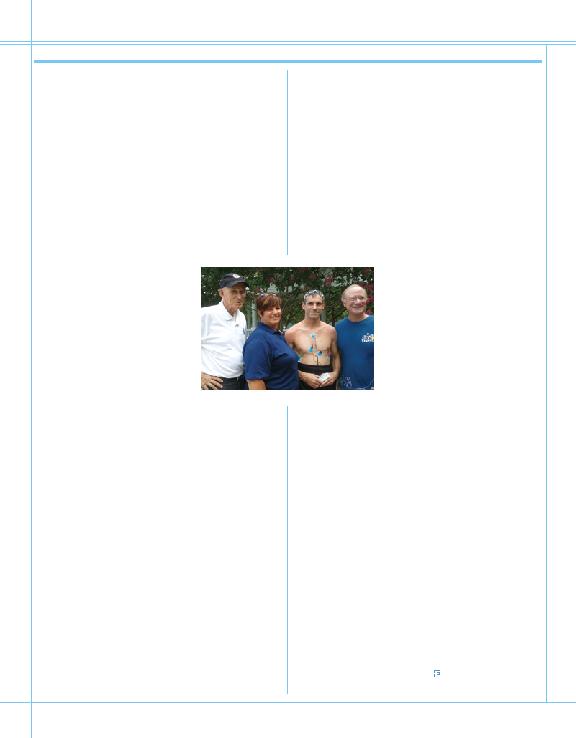
We will measure Ben's heart rate at odd intervals over his
swim, such as while he's sleeping and when he's napping
in between. We want to look at the changes that occur
on a day-to-day basis throughout each of those events. I
want to make sure that we have the right length of cable
for Ben. I also want him to be comfortable while he's
swimming in the ocean, so I didn't want to wait too long
to perform some tests. The device is waterproofed for
half an hour, which is a long time for a Holter monitor.
I found a small company that made a little pouch for
insulin pumps and it fits the monitor just perfectly. So
we tested it in the Pacific Ocean with some surfers, and
we also took it and floated it off the dock overnight to
make sure that the device would stay
dry. Then I tested the cables in the
Caribbean Sea for four days to make
sure that they don't corrode. We're
going to have five Holter monitors on
the boat. On the average, the device
lasts for years. We have some devices
out there that are about nine years
old. A little history on the device
In the 60s, Norman Holter developed
the Holter monitor. It used to be
placed in a big backpack and carried
on one's back. Over time, the device has gotten smaller
and began to incorporate more features. Who is going
to see the data we collect? Data sheets will be posted
daily on our Web site and, of course, The Longest Swim
Web site would have that information. Some data will be
downloaded at the boat. I'm a certified cardio-tech. I will
review the data and put it into the format that people can
understand so they're able to see changes. The data can
also be used for other studies.
Our goal is to make sure that Ben is safe. With the
device, we can monitor Ben throughout the event. We
will see EKG recordings while he's swimming. We're
also monitoring him periodically when he's on board
the ship. Ben is in fantastic shape, but we just want to
make sure he's protected. If we can just get him from
Tokyo to San Francisco without the sharks getting to him,
that would be a success. We work with a lot of athletes,
Olympians, cyclists, you name it, and we're interested in
world-class athletes. A primary question that we hope
to answer for anyone is `what can I do? If I'm not an
much activity to prolong life. After nine years of exercise,
you can decrease death from 50 to 65%. So what we're
pioneering here is the concept that people can take care
of themselves instead of becoming dependent on the
government and insurance companies...it's what you
can do for yourself that's going to improve the health of
Americans. Obesity is epidemic in America today. Child
obesity has increased....diabetes has increased. We're
killing ourselves right now. So what we are trying to do
is make the American people aware of what's happening
in this country in comparison to other nations. We've
introduced the concept internationally and they embrace
it. Ben will make it. I will be praying and I know he
will. The technology that is used in space will be used to
Pacific. I'm glad to be a part of it; Ben
is a very nice person and a world-
class athlete!
in the structure and function of his
heart. Before Ben started his swim,
we had already done an extensive
amount of electrocardiography,
before and after a full-hour swim
Southwestern with advanced imaging of the right and
left ventricle, including the very sensitive test for scar
of the heart. There's some concern within the medical
community that extraordinary exercise has a potential to
damage the heart. We've already studied Charlie Engle,
the world's greatest endurance runner. He ran across the
Sahara desert. He was setting the world's speed record
for running across the United States in forty-five days,
3,000 miles. We studied him just like we did with Ben
- before and after that race. We're very interested in
seeing how an extraordinary swimming effort compares
to an extraordinary running effort. With Charlie, we were
able to stop and conduct echocardiograms on the side
of the road. With Ben, we're not going to do that. So
we're hoping to place a portable Holter machine on the
boat and guide the nurse practitioner (on the boat) from
Johnson Space Center and NASA, just like we do with the
astronauts in the space station. Our plan is to perform
echocardiogram once a month over the course of the
swim to see how Ben's heart adapts and responds to the
extraordinary endurance effort.